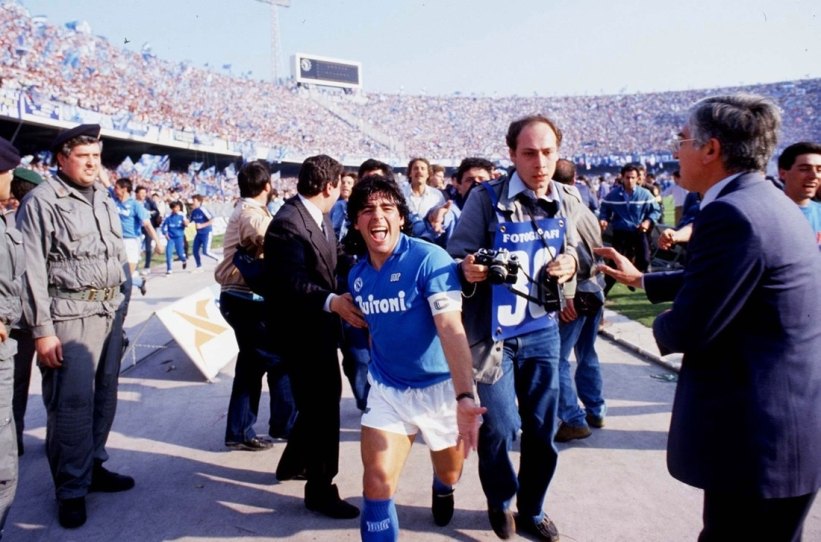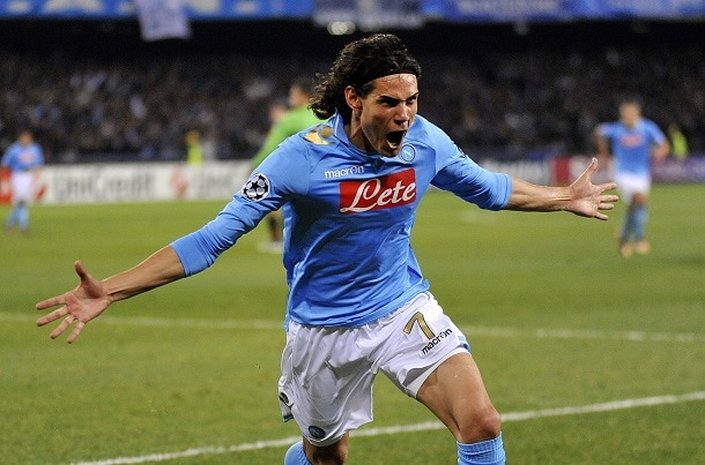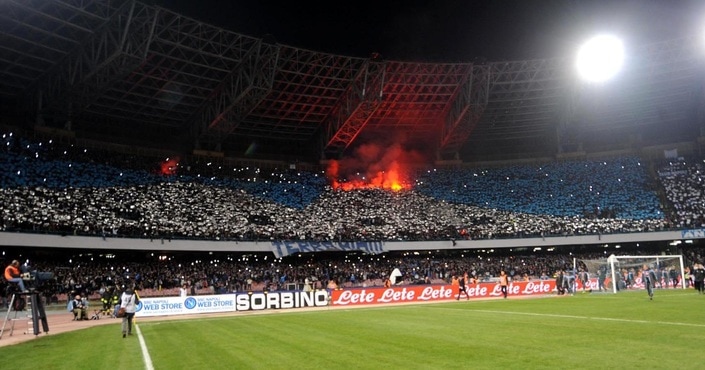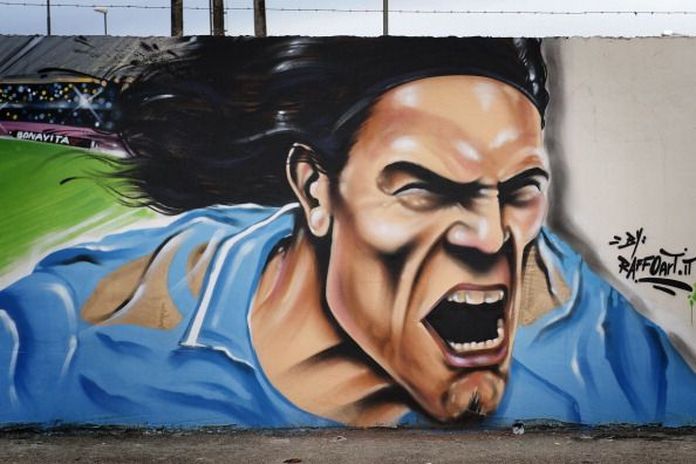It was the end of 2009/10 Serie A season and opinions were divided regarding the success of Napoli’s campaign. At the season’s inception, great optimism had surrounded the San Paolo after president Aurelio De Laurentiis had paid big money to bring in local boy Fabio Quagliarella from Udinese. But by the summer of 2010, Quagliarella’s performances had yet to convince. Despite managing 11 league goals, his season was neither deemed a huge success, nor his acquisition money well spent.
Before the beginning of the 2010/11 season, questions about his future were already being raised. Meanwhile, doubt also surrounded the future of Palermo’s promising star man, Edinson Cavani. Although far from a world class forward at this point, many saw and believed in Cavani’s potential.
One of those people was De Laurentiis. He wasted little time and acted on Cavani’s ambitions to join a bigger club, beating off stiff competition from other Serie A giants to secure the young prospect. The deal, which was a loan with an obligation to buy, was a shrewd piece of business.
Soon after the Uruguayan’s arrival, Quagliarella was shipped out to bitter rivals Juventus, much to the disgust of certain sections of Napoli’s fanatical support. (Not at the sale of the player, but at the identity of the club he had decided to join).
The 2010/11 Serie A campaign would also be coach Walter Mazzari’s first full season in charge, having been recruited in October of the previous season to replace the failing Roberto Donadoni. Mazzari’s prowess was immediately evident. With Marek Hamsik and Ezequiel Lavezzi supporting Cavani in attack, his lethal 3-4-2-1 system allowed the former Palermo man to explode onto the world stage.
The Uruguayan prodigy went on to score in his first four matches, including a dramatic late winner at Sampdoria. But the pinnacle of the season came on 9 January 2011, as Cavani scored an unforgettable hat-trick against bitter rivals Juventus in front of a packed Stadio San Paolo. The thrilling performance cemented his reputation as a fan favourite.
Read ‘Napoli – Juventus: A Tale of Regional Divide’
El Matador (a nickname given to him whilst at Palermo) would go on to score another two hat-tricks that season against Sampdoria and Lazio, finishing the campaign with 26 goals. At that time, the achievement made Cavani the highest league goal-scorer in Napoli’s history. Ironically, despite his best efforts, it was another son of Naples, Antonio Di Natale, who finished top of the scoring charts that season; registering a remarkable 28 goals with a high-flying Udinese side.
Yet Cavani’s performances undeniably helped Napoli secure a successful third place finish. This meant automatic qualification for the Champions League for the first time since the days of Diego Maradona. And indeed, the buzz El Matador created in Naples had not been seen since the days of the Argentine ‘Messiah’. With the Uruguayan hitman leading the line, the tifosi were beginning to dream.

Read ‘Argentine’s and Serie A (Part III): Diego Maradona and Napoli’
Cavani was once again instrumental throughout the 2011/12 season, scoring vital goals in the team’s impressive Champions League run, including a double against Manchester City at the Stadio San Paolo. Unfortunately, a first leg goal in the round of 16 wasn’t enough to keep Napoli in the competition and the Azzurri went out in extra time to the eventual winners, Chelsea. Despite this heartbreaking exit, the team and especially Cavani, received high praise across Europe for their performances.
El Matador finished the Champions League campaign with an eye-catching five goals and was now beginning to attract attention from Europe’s biggest clubs. After finishing the Serie A season with 23 goals, on 20 May 2012, Cavani and Napoli had the chance to end their 21 year trophy drought. It would not be easy, as they faced Antonio Conte’s Juventus in the Coppa Italia final; a side that had finished their domestic campaign unbeaten.
In a closely fought affair, it was none other than the omnipotent Uruguayan who opened the scoring, converting from the penalty spot in the 63rd minute. Hamsik went on to seal the historic victory in the 83rd minute to send Napoletani into delirium and elevate Edinson to iconic status amongst its people. Naples, so often derided but unwaveringly proud, had finally found its new saviour.
Football is known for its passion, but there are few sets of supporters that can equal the love and fanaticism the Neapolitans have for their football team. These visceral emotions can be compared to the feelings of love and tenderness a mother holds for her child.
Read about the Partenopei’s Ultras in ‘Napoli: The Alternative Club Guide’
Edinson was now undisputedly a mainstay in the hearts of all Neapolitans. It was a cocktail of love and affection he will struggle to find anywhere else in world football. Despite the successes however, juggling three competitions ultimately resulted in Napoli finishing the 2011/12 season in fifth place, qualifying for the Europa League.
Whilst a player of Cavani’s class belonged in the Champions League, the sought-after forward cast aside any and all interest from rival clubs around Europe and prepared for the upcoming campaign.
And Cavani’s best in a Napoli shirt was yet to come. After two glorious seasons, the 2012/13 campaign proved his best yet. He netted a sublime hat-trick early on against Lazio, and later in November, he scored all four goals in a Europa League match against Ukrainian side Dnipro. Cavani’s ability to produce his best in big matches was inducing fainting fits of joy among Napoli fans. In January, he scored yet another hat-trick against fierce rivals Roma in the Derby of the Sun and would add to his tally of trebles against Inter. Unsurprisingly, Cavani finished the season as Capocannoniere, with yet another record breaking 29 goals. This helped Napoli finish second, their highest position since the 1990 Scudetto.
The quality and consistency of his performances were undeniable. Now considered one of the best strikers in the world, he was linked with moves to financial powerhouses like Manchester City, Real Madrid and Paris Saint-Germain. Although reaffirming his commitment to Napoli and acknowledging the positive impact Italian football had had on his career, the lure of Europe’s giants proved too appealing for Cavani and in July 2013, he joined PSG.
After three truly remarkable seasons, he moved on for a fee estimated to be €64 million, the sixth largest transfer in history at the time.
Opinions surrounding Cavani’s departure were divided. The importance of his goals and the heart he had shown when on the pitch softened the blow for many fans. By the end of his time in Naples, Cavani was the fourth highest goal scorer in the club’s history, with a remarkable 104 goals in 138 games across all competitions.
Despite this success, his impact in Naples remains understated. It is true, his goals may never be forgotten and amongst Napoletani, he remains an icon. But Cavani’s performances were also crucial to the club’s overall renaissance. Before Cavani’s arrival, the highest Napoli had finished since bankruptcy in 2004 was sixth.
Neapolitan artist ‘Raffo’ designed this seven-meter mural painting in honour of Edinson Cavani
His performances secured Naples Champions league football for the first time in decades; his performances that inspired Napoli to their first trophy in decades; and his performances that earned the club €65 million to spend in the transfer market.
Before Cavani, Napoli’s big players like Lavezzi and Hamsik were signed as young prospects for under €10 million. The €18 million paid for Quagliarella was a record fee at the time, and only success would allow Napoli to keep spending that way. However, success didn’t come with Fabio…it came with Edinson.
The season before signing for the Partenopei, the Uruguayan had scored 13 times for Palermo. It was an impressive goal tally, but no one expected him to explode in Naples the way he did. In Campania, he settled and became a world class footballer. De Laurentiis took a punt on Cavani, and his investment was repaid millions of times over.
The Champions League campaigns provided Napoli income to bolster and secure their future, not to mention it was the eventual Cavani fee that allowed them to sign the likes of Rafael Benitez, Gonzalo Higuain, Jose Callejon, Dries Mertens and Raul Albiol. Before Cavani, Napoli would never have been able to attract such players. El Matador put this once great southern team back on world football’s map.
Indeed, it is safe to say that a direct correlation exists between Cavani’s performances on the field, and Napoli’s consequent success off it. Without Cavani, there would be no Higuaín, and without Higuain there would be no €90 million to spend, nor a current Champions League campaign in which to compete.
And thus I conclude by asking; had Edinson Cavani not been such a success, would Napoli still be the team they are today?
Words by Ciro
Ciro currently lives in Melbourne, Australia. His parents are Italian and his Neapolitan mother ensured that Napoli has always been the team of his heart. Writing about all things calcio is his greatest passion.




